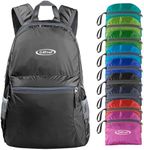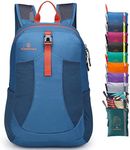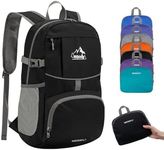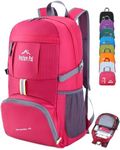Buying Guide for the Best Foldable Backpack
Choosing the right foldable backpack can make your travels, hikes, or daily commutes much more convenient. A foldable backpack is designed to be lightweight and compact, making it easy to store when not in use. To find the best fit for you, consider the following key specifications and how they align with your needs.CapacityCapacity refers to the volume of the backpack, usually measured in liters. This spec is important because it determines how much you can carry. Small capacity (10-20 liters) is suitable for day trips or carrying essentials like a water bottle, snacks, and a light jacket. Medium capacity (20-30 liters) is ideal for longer day trips or carrying more items like books, a tablet, or extra clothing. Large capacity (30+ liters) is best for overnight trips or carrying bulkier items. Choose a capacity based on the amount and type of items you plan to carry regularly.
MaterialThe material of the backpack affects its durability, weight, and water resistance. Common materials include nylon, polyester, and ripstop fabric. Nylon is lightweight and durable, making it a good all-around choice. Polyester is also durable and often more affordable. Ripstop fabric is designed to prevent tears and is ideal for rugged use. If you need a backpack for outdoor activities or travel, consider a more durable material. For light, everyday use, a standard nylon or polyester backpack may suffice.
WeightWeight is crucial for a foldable backpack since it is meant to be lightweight and easy to carry. A lighter backpack (under 0.5 pounds) is perfect for those who prioritize minimalism and portability. Slightly heavier backpacks (0.5-1 pound) may offer more features and durability. Consider how much weight you are comfortable carrying and how important portability is for your intended use.
Folded SizeFolded size refers to how small the backpack can be packed down when not in use. This is important for storage and portability. A smaller folded size (comparable to a wallet or small book) is ideal for travelers who need to save space in their luggage. Larger folded sizes (comparable to a small pouch) may offer more features but take up more space. Choose a folded size based on how much storage space you have and how compact you need the backpack to be.
Compartments and PocketsCompartments and pockets help organize your belongings. A simple design with one main compartment is lightweight and easy to use, suitable for carrying a few items. Additional pockets, such as front pockets, side pockets, and internal compartments, provide better organization and accessibility. If you carry various items and need to keep them organized, look for a backpack with multiple compartments. For minimal use, a simpler design may be more appropriate.
Water ResistanceWater resistance is important if you plan to use the backpack in wet conditions. Some backpacks are made from water-resistant materials or have a water-resistant coating, which can protect your belongings from light rain. Fully waterproof backpacks offer the highest level of protection but may be heavier and more expensive. Consider the typical weather conditions you will encounter and how important it is to keep your items dry when choosing the level of water resistance.
Comfort FeaturesComfort features such as padded shoulder straps, breathable back panels, and adjustable straps can make a big difference, especially if you plan to carry the backpack for extended periods. Padded shoulder straps distribute weight more evenly and reduce strain. Breathable back panels help keep you cool. Adjustable straps ensure a better fit. If comfort is a priority, look for these features. For short-term or light use, you may not need as many comfort features.



















